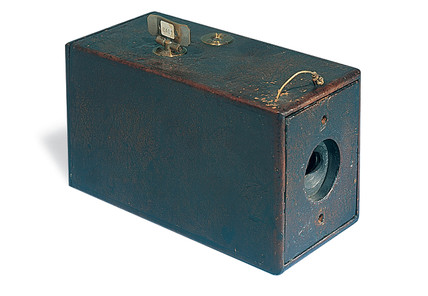In 1884, the world of photography was changed forever through the invention of film. The bulky, cumbersome photographic plates which had been the standard in photography up until this point became a thing of the past as they were replaced by the much more practical film roll technology.
George Eastman and Kodak
At age twenty-three George Eastman abandoned his career as a bank clerk and started working in a photographic lab. It was then that George imagined a new type of photographic plate which would be lighter and more portable. This would become what Eastman called the “dry plate” and what we call “film.” Once he had fully worked out this technology, Eastman invented a compact camera to compliment the film and started his own company to market this product.
This original “film” was coated on paper. The first transparent plastic film was produced in 1889. Before this, glass photographic plates were used, which were far more expensive and cumbersome, albeit also of better quality. The first photographic film was made from highly flammable nitrocellulose with camphor as a plasticizer (celluloid). Beginning in the 1920s, nitrate film was replaced with cellulose acetate or “safety film”. This changeover was not completed until 1933 for X-ray films (where its flammability hazard was most acute) and for motion picture film until 1951. The company was called “Eastman Kodak” and continues to be one of the largest commercial photography companies to this day. (You know – Kodak, as in “Kodak moment.”)
Eastman’s Kodak camera was sold to consumers with 100 pictures-worth of film preloaded. For the first time, a camera had been built which was small enough to take anywhere, and which required no technical knowledge to use. Any person with $25 could buy Eastman’s camera and take pictures with the push of a button. Once the customer had taken 100 pictures, they would merely post the camera back to the Eastman Kodak Co. and within weeks they would receive back prints of their pictures and a fresh load of film. This sudden burst of accessibility completely changed the photography industry. Eastman Kodak’s slogan was “You press the button, we do the rest.”
As the world moved into the twentieth century photography was still attempting to define its role in society. As photography became more accessible, it in some ways took over the function which painting had fulfilled in the nineteenth century. Many felt, that it was a superior tool for creating realistic portraits, as well as landscape and still life studies. At the same time, advances in the technology of film resulted in increased commercialization as well as the rapid development of the world’s newest art form: cinema.
But throughout all of these changes, photography as an art never ceased to flourish, and many of the photographs which have become indelible elements of our global consciousness were created during this period.
Special Films
Instant photography, as popularised by Polaroid, uses a special type of camera and film that automates and integrates development, without the need of further equipment or chemicals. This process is carried out immediately after exposure, as opposed to regular film, which is developed afterwards and requires additional chemicals. See instant film.
Films can be made to record non-visible ultraviolet (UV) and infrared (IR) radiation. These films generally require special equipment; for example, most photographic lenses are made of glass and will therefore filter out most ultraviolet light. Instead, expensive lenses made of quartz must be used. Infrared films may be shot in standard cameras using an infrared band- or long-pass filter, although the infrared focal point must be compensated for.
Exposure and focusing are difficult when using UV or IR film with a camera and lens designed for visible light. The ISO standard for film speed only applies to visible light, so visual-spectrum light meters are nearly useless. Film manufacturers can supply suggested equivalent film speeds under different conditions, and recommend heavy bracketing. e.g. with a certain filter, assume ISO 25 under daylight and ISO 64 under tungsten lighting. This allows a light meter to be used to estimate an exposure. The focal point for IR is slightly farther away from the camera than visible light, and UV slightly closer; this must be compensated for when focusing. Apochromatic lenses are sometimes recommended due to their improved focusing across the spectrum.
Film optimized for sensing X-ray radiation is commonly used for medical imaging by placing the subject between the film and a source of X-rays, without a lens, as if a translucent object were imaged by being placed between a light source and standard film.
Film optimized for sensing X-rays and for gamma rays is sometimes used for radiation dosimetry and personal monitoring.
Film has a number of disadvantages as a scientific detector: it is difficult to calibrate for photometry, it is not re-usable, it requires careful handling (including temperature and humidity control) for best calibration, and the film must physically be returned to the laboratory and processed. Against this, photographic film can be made with a higher spatial resolution than any other type of imaging detector, and, because of its logarithmic response to light, has a wider dynamic range than most digital detectors. For example, Agfa 10E56 holographic film has a resolution of over 4,000 lines/mm—equivalent to a pixel size of 0.125 micrometres—and an active dynamic range of over five orders of magnitude in brightness, compared to typical scientific CCDs that might have pixels of about 10 micrometres and a dynamic range of 3-4 orders of magnitude.
Special films are used for the long exposures required by astrophotography.


